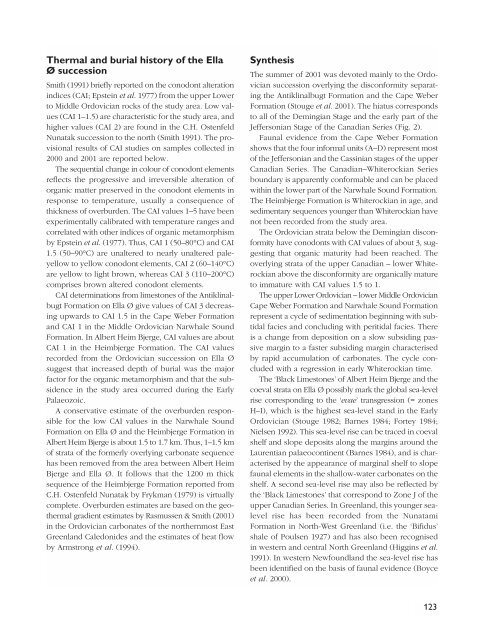Review of Greenland Avtivities 2001 - Geus
Review of Greenland Avtivities 2001 - Geus
Review of Greenland Avtivities 2001 - Geus
Create successful ePaper yourself
Turn your PDF publications into a flip-book with our unique Google optimized e-Paper software.
Thermal and burial history <strong>of</strong> the Ella<br />
Ø succession<br />
Smith (1991) briefly reported on the conodont alteration<br />
indices (CAI; Epstein et al. 1977) from the upper Lower<br />
to Middle Ordovician rocks <strong>of</strong> the study area. Low values<br />
(CAI 1–1.5) are characteristic for the study area, and<br />
higher values (CAI 2) are found in the C.H. Ostenfeld<br />
Nunatak succession to the north (Smith 1991). The provisional<br />
results <strong>of</strong> CAI studies on samples collected in<br />
2000 and <strong>2001</strong> are reported below.<br />
The sequential change in colour <strong>of</strong> conodont elements<br />
reflects the progressive and irreversible alteration <strong>of</strong><br />
organic matter preserved in the conodont elements in<br />
response to temperature, usually a consequence <strong>of</strong><br />
thickness <strong>of</strong> overburden. The CAI values 1–5 have been<br />
experimentally calibrated with temperature ranges and<br />
correlated with other indices <strong>of</strong> organic metamorphism<br />
by Epstein et al. (1977). Thus, CAI 1 (50–80°C) and CAI<br />
1.5 (50–90°C) are unaltered to nearly unaltered paleyellow<br />
to yellow conodont elements, CAI 2 (60–140°C)<br />
are yellow to light brown, whereas CAI 3 (110–200°C)<br />
comprises brown altered conodont elements.<br />
CAI determinations from limestones <strong>of</strong> the Antiklinalbugt<br />
Formation on Ella Ø give values <strong>of</strong> CAI 3 decreasing<br />
upwards to CAI 1.5 in the Cape Weber Formation<br />
and CAI 1 in the Middle Ordovician Narwhale Sound<br />
Formation. In Albert Heim Bjerge, CAI values are about<br />
CAI 1 in the Heimbjerge Formation. The CAI values<br />
recorded from the Ordovician succession on Ella Ø<br />
suggest that increased depth <strong>of</strong> burial was the major<br />
factor for the organic metamorphism and that the subsidence<br />
in the study area occurred during the Early<br />
Palaeozoic.<br />
A conservative estimate <strong>of</strong> the overburden responsible<br />
for the low CAI values in the Narwhale Sound<br />
Formation on Ella Ø and the Heimbjerge Formation in<br />
Albert Heim Bjerge is about 1.5 to 1.7 km. Thus, 1–1.5 km<br />
<strong>of</strong> strata <strong>of</strong> the formerly overlying carbonate sequence<br />
has been removed from the area between Albert Heim<br />
Bjerge and Ella Ø. It follows that the 1200 m thick<br />
sequence <strong>of</strong> the Heimbjerge Formation reported from<br />
C.H. Ostenfeld Nunatak by Frykman (1979) is virtually<br />
complete. Overburden estimates are based on the geothermal<br />
gradient estimates by Rasmussen & Smith (<strong>2001</strong>)<br />
in the Ordovician carbonates <strong>of</strong> the northernmost East<br />
<strong>Greenland</strong> Caledonides and the estimates <strong>of</strong> heat flow<br />
by Armstrong et al. (1994).<br />
Synthesis<br />
The summer <strong>of</strong> <strong>2001</strong> was devoted mainly to the Ordovician<br />
succession overlying the disconformity separating<br />
the Antiklinalbugt Formation and the Cape Weber<br />
Formation (Stouge et al. <strong>2001</strong>). The hiatus corresponds<br />
to all <strong>of</strong> the Demingian Stage and the early part <strong>of</strong> the<br />
Jeffersonian Stage <strong>of</strong> the Canadian Series (Fig. 2).<br />
Faunal evidence from the Cape Weber Formation<br />
shows that the four informal units (A–D) represent most<br />
<strong>of</strong> the Jeffersonian and the Cassinian stages <strong>of</strong> the upper<br />
Canadian Series. The Canadian–Whiterockian Series<br />
boundary is apparently conformable and can be placed<br />
within the lower part <strong>of</strong> the Narwhale Sound Formation.<br />
The Heimbjerge Formation is Whiterockian in age, and<br />
sedimentary sequences younger than Whiterockian have<br />
not been recorded from the study area.<br />
The Ordovician strata below the Demingian disconformity<br />
have conodonts with CAI values <strong>of</strong> about 3, suggesting<br />
that organic maturity had been reached. The<br />
overlying strata <strong>of</strong> the upper Canadian – lower Whiterockian<br />
above the disconformity are organically mature<br />
to immature with CAI values 1.5 to 1.<br />
The upper Lower Ordovician – lower Middle Ordovician<br />
Cape Weber Formation and Narwhale Sound Formation<br />
represent a cycle <strong>of</strong> sedimentation beginning with subtidal<br />
facies and concluding with peritidal facies. There<br />
is a change from deposition on a slow subsiding passive<br />
margin to a faster subsiding margin characterised<br />
by rapid accumulation <strong>of</strong> carbonates. The cycle concluded<br />
with a regression in early Whiterockian time.<br />
The ‘Black Limestones’ <strong>of</strong> Albert Heim Bjerge and the<br />
coeval strata on Ella Ø possibly mark the global sea-level<br />
rise corresponding to the ‘evae’ transgression (= zones<br />
H–I), which is the highest sea-level stand in the Early<br />
Ordovician (Stouge 1982; Barnes 1984; Fortey 1984;<br />
Nielsen 1992). This sea-level rise can be traced in coeval<br />
shelf and slope deposits along the margins around the<br />
Laurentian palaeocontinent (Barnes 1984), and is characterised<br />
by the appearance <strong>of</strong> marginal shelf to slope<br />
faunal elements in the shallow-water carbonates on the<br />
shelf. A second sea-level rise may also be reflected by<br />
the ‘Black Limestones’ that correspond to Zone J <strong>of</strong> the<br />
upper Canadian Series. In <strong>Greenland</strong>, this younger sealevel<br />
rise has been recorded from the Nunatami<br />
Formation in North-West <strong>Greenland</strong> (i.e. the ‘Bifidus’<br />
shale <strong>of</strong> Poulsen 1927) and has also been recognised<br />
in western and central North <strong>Greenland</strong> (Higgins et al.<br />
1991). In western Newfoundland the sea-level rise has<br />
been identified on the basis <strong>of</strong> faunal evidence (Boyce<br />
et al. 2000).<br />
123

















